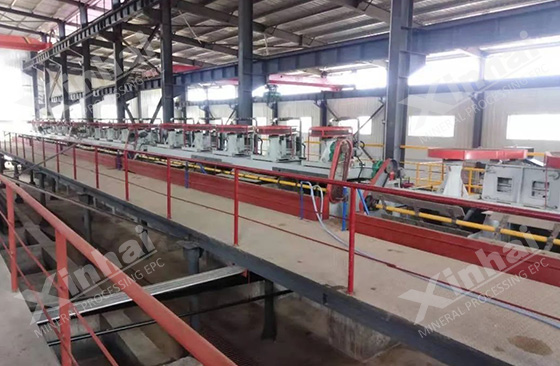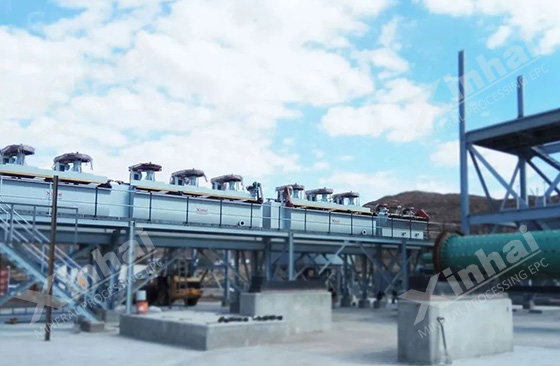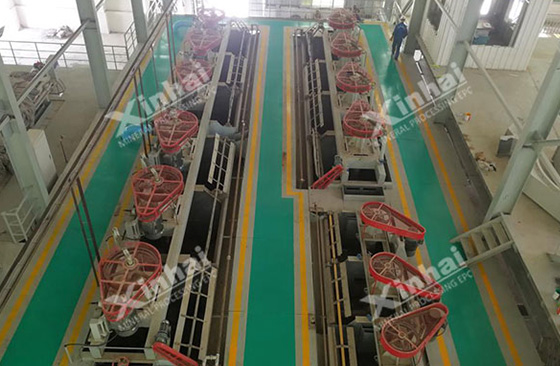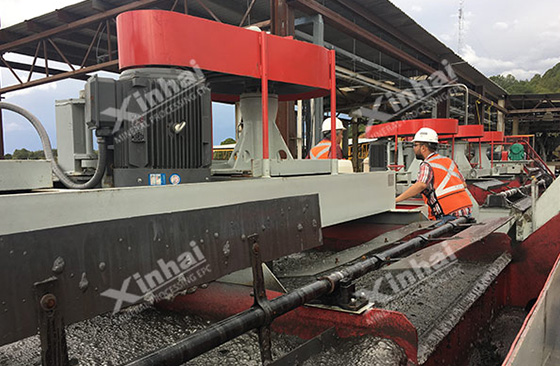
Classification of copper ores from the perspective of sorting, copper ores can be divided into oxide ores, sulfide ores, and mixed ores. According to the number of useful minerals or valuable elements contained in the ore, copper ore can be divided into single copper ore and polymetallic copper ore. According to the copper content in the copper ore, it can be divided into rich copper ore and medium copper ore. ore, poor copper ore and extremely poor copper ore. The main separation method for copper minerals is flotation. When dealing with refractory oxidized ores, other methods will be used. Copper minerals use xanthate collectors and pine oil foaming agents. Different co-flow ores have different sorting technologies. The following will introduce you to the sorting technologies of different types of copper ores.
Copper-sulfur ore contains copper sulfide minerals and iron sulfide ores, which can generally be divided into two types:
(1) Dense massive copper-bearing pyrite: The gangue mineral content is small, and the method of preferential flotation of copper sulfide ore is often used. The tailings after copper flotation are sulfide concentrates.
(2) Disseminated copper-bearing iron ore: The content of copper sulfide minerals and iron sulfide minerals in the ore is low, and the content of gangue minerals is high. Ore concentrators often use a mixed flotation process to process this type of ore. First, copper sulfide and iron sulfide minerals are mixed and flotated. After the tailings are discarded, the mixed concentrate is reground and separated.

The flotation methods of copper-sulfur ores can be divided into two categories: one is magnetic first and then flotation, and the other is flotation first and then magnetic. Production practice has proven that if the magnetic first and then flotation process is selected, pyrrhotite will enter the magnetite concentrate during magnetic separation, affecting the mineral processing indicators. Therefore, concentrators often choose the solution of first flotation and then magnetic separation: first float out the sulfide ore, and then magnetically separate the magnetite in the tailings. During the process, attention should be paid to strengthening the flotation of iron sulfide ore when flotating sulfide ore, and trying to float out all the pyrrhotite. Otherwise, during the magnetic separation of magnetite, pyrrhotite will be mixed into the iron concentrate, affecting the iron content. The quality of the concentrate. If pyrrhotite is mixed into iron concentrate, the iron concentrate needs to be desulfurized if necessary, and the pyrrhotite should be removed by reverse flotation.

In the flotation process of complex sulfide ores, the separation of copper and zinc ores is relatively difficult, mainly for two reasons:
(1) Copper and zinc minerals are densely symbiotic, and chalcopyrite exists in fine-grained disseminated sphalerite, making it difficult to dissociate into monomers.
(2) When the surface of sphalerite is activated by copper ions, its floatability is similar to that of copper minerals, which can easily cause separation difficulties.
In order to improve the separation effect of copper and zinc, several measures can be taken:
(1) To precipitate copper ions in the slurry to prevent activation of sphalerite, sodium sulfide agent can be used. In addition to sodium sulfide, cation exchange resin can also be used and added to the ball mill. It can absorb copper ions in the slurry and prevent copper ions from activating sphalerite.
(2) Use deactivating agents such as sodium cyanide and sulfuric acid to remove copper ions adsorbed on the surface of sphalerite.
(3) Decontamination is carried out before the separation of the copper-zinc mixed concentrate, and activated carbon or sodium sulfide is used to remove the collector on the surface of the ore particles to facilitate separation.

The copper and lead separation solutions are mainly divided into two types: floating copper and copper suppression. The main methods used in mineral processing plants are as follows:
(1) Dichromate method: Dichromate is used to inhibit the flotation of copper minerals from galena. This method has a better inhibitory effect on over-oxidized galena.
(2) Cyanide method: Since cyanide has a strong inhibitory effect on chalcopyrite, while galena has almost no inhibitory effect, this method is mainly used to suppress copper and lead floating.
(3) Oxygen-sulfur method: Use sulfur dioxide or sulfite combined with other inhibitors to inhibit the flotation of chalcopyrite from galena.
(4) Heating method: First use steam to heat the copper-lead mixed concentrate to about 60°C. In acidic or neutral slurry, the collector on the surface of galena is desorbed, and the surface is oxidized and hydrophilic, and the copper is still floating.

The above is a brief introduction to copper mineral sorting technology. Copper ores often coexist with minerals such as lead and zinc. In order to maximize the utilization of mineral resources, it is necessary to consider the composition of the original mineral and the proportion of useful minerals in the mixed concentrate obtained by sorting. Only in this way can the appropriate mineral processing method be selected to reduce the impurity content in the concentrate and improve the quality and grade of the concentrate.
To find out more about our products and solutions, please fill out the form below and one of our experts will get back to you shortly.